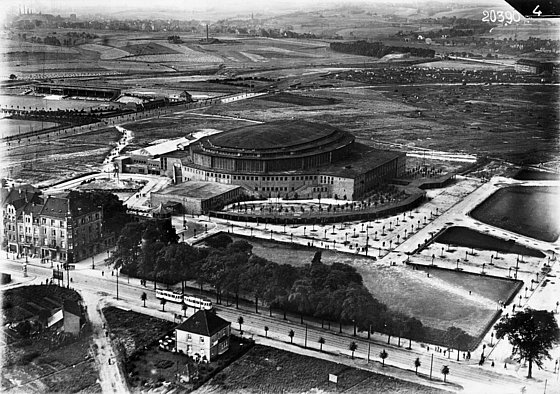
Dortmund's Westfalenhalle - a technical masterpiece of its time
Dr.-Ing. Kirsten Stopp / Building with existing structures and building construction
Photo: connectINGs GmbH
A technical masterpiece of its time
Civil engineer Kirsten Stopp on the opening of Dortmund's Westfalenhalle on 28 November 1925
Between April and November 1925, Dortmund's Westfalenhalle was built as a wooden structure. For a time, it was the largest hall in Europe. What was the reason for this?
Kirsten Stopp: The Dortmund Westfalenhalle was considered a technical masterpiece at the time of its construction. Its patented timber construction by the Carl Tuchscherer company enabled a span of around 76 metres - in combination with the large usable area, it set new standards in timber hall construction. The term "span" describes the space that can be bridged without supporting elements.
The self-supporting construction was based on four mighty wooden truss arches, each arranged 20 metres apart in a transverse direction. Another special architectural and technical feature was the elliptical floor plan of the hall: it enabled the integration of a cycling track with a track length of 200 metres. This track was also designed in such a way that it could be easily assembled and dismantled. At the same time, the elliptical shape offered around 12,000 spectators a good view of the action from every seat.
However, the truly extraordinary thing about the hall designed by Breslau architect Ludwig Hermann Moshamer and Dortmund city planning officer Dr Wilhelm Delfs was the combination of technical excellence and functional versatility: the hall set standards in terms of span and area alone - the fact that it was also planned for multifunctional use from the outset made it a structural innovation of its time.

Dortmund's Westfalenhalle 1927
Photo: dl-en/by-2-0
It was officially opened on 28 November 1925. How was the hall used back then?
Kirsten Stopp: From the very beginning, the Westfalenhalle was a multifunctional venue that was used for a variety of major events:
On the one hand, for a wide variety of sporting events: at the time, it was best known for the legendary six-day cycling races. But it also hosted equestrian tournaments, athletics and all kinds of indoor sports competitions. Not forgetting, of course, Max Schmeling's boxing match in 1927, in which he won the European title.
On the other hand, it was a major event centre: cultural events such as concerts, theatre performances, circus shows and folk festivals took place here, as well as social events, trade fairs and exhibitions. In the first few years after its opening, the hall was mainly used regionally, but over time it also attracted an international audience.
The Westfalenhalle was also the venue for political and social gatherings, including party conferences of the National Socialist movement in the 1930s.
The Nazis confiscated the hall when the war broke out and used it as a prison camp. When the hall was destroyed by a bombing raid on 23 May 1944, thousands of prisoners of war died as they had no protection. After the war, the reconstruction of the hall began with steel and concrete and a very special roof construction. What was so special about it?
Kirsten Stopp: When it opened, the roof construction of the Westfalenhalle was one of the largest self-supporting domes in Europe and was an outstanding example of modern architecture. The design by Walter Höltje, who worked on the project together with Horst Retzki, consisted of an innovative roof and wall construction for the time: a steel structure with a self-supporting domed roof and a glazed steel skeleton enclosing the outer wall. The construction made it possible to dispense with disruptive supporting pillars in the interior - still a technical advance for the time - and thus turn the hall into a flexible space for various events. The floor plan was again designed elliptically according to the requirements of a cycling track. This innovative construction caused a worldwide architectural sensation and contributed significantly to the functionality and aesthetics of the hall.
Specifically, the load-bearing roof structure consists of a ring of 20 curved steel beams that rest on the reinforced concrete grandstands at the bottom and lead into a central oval ring at the top. However, no forces are transferred to this ring. Instead, the steel girders are held in place by tie rods that run along the outside of the façade and into the concrete foundation. This technique made it possible to install a working platform under the oval ring. The façade consists of a large, delicate glass wall that envelops the building and creates a transparent, light effect, although the interior is a solid concrete structure.
Consequently, the Westfalenhalle has been on the city of Dortmund's list of monuments since 1996 - due to its significance as a symbol of reconstruction after the Second World War and as a technical and architectural masterpiece of its time.

Westfalenhalle Dortmund 2008 with the U on the roof
Photo: CC BY-SA 3.0
The roof weighed 1300 tonnes at the time. That was quite a feat of construction, wasn't it?
Kirsten Stopp: Yes, especially when you consider how much manual labour was still involved back then. To assemble the construction cranes, the construction workers climbed to lofty heights without any safety precautions, sometimes over steep, slippery surfaces that were not even waist-wide. Transporting the steel girder sections through the city to the construction site by lorry at a height of 4 metres also proved difficult. Once there, the steel girder sections first had to be pulled inside the hall by hand using a cable winch. Although the crane then helped to lift the girder section, the workers had to stand on it while it was being swivelled to align it - unimaginable by today's safety standards. The situation was similar when it came to screwing on the steel connectors on which the roof covering would later rest - here they moved on thin beams at a height of 20-25 metres above the ground. In addition to the certainly physically demanding work, there was also the time pressure at the end: the hall had to be ready quickly after the war as a symbol of reconstruction and for events. The first event was scheduled for 2 February 1952 - after 1.5 years of construction. The deadline was met and a grand opening event took place.
Dortmund had thus once again realised an impressive self-supporting roof construction: technically innovative, architecturally elegant and a symbol of progress in post-war Germany. At the time, Lord Mayor Fritz Henßler rightly called it "a representation of the efficiency of Dortmund's industrial and commercial economy".
After all, wood is our local raw material. And with the timber construction technology available today, wood can easily keep up with even the most stringent construction standards for load-bearing structures with large spans. The largest modern hall in timber construction in Europe is a logistics hall in the port of Straubing-Sand with an area of 27,000 square metres. Is there a rethink in terms of ecological aspects today?
Kirsten Stopp: Thanks to the sustainability debate, wood is currently experiencing a renaissance. As an indigenous and renewable raw material, wood conserves resources and has a significantly lower CO2 footprint than conventional building materials. It is also recyclable.
There is still a lot of mistrust of wood as a building material - which is why flagship projects like the one in Straubing-Sand are immensely important. As there are no comparable halls in timber construction, a new fire protection concept had to be developed first. This is more complex than for halls made of conventional building materials, but then fulfils the same requirements in full. Unlike the Westfalenhalle, however, the span of the logistics hall does not play a role; here the large surface area of the pure timber construction and the sustainability aspect take centre stage.
World-famous artists such as Bob Marley, Prince and Pink Floyd, who only used four concert halls worldwide during their world tour for 'The Wall' due to the complex stage construction, came to Dortmund. The optimal location of the building also plays a role, doesn't it?
Kirsten Stopp: Yes, even back then Dortmund was an industrially and culturally important city in western Germany, which also had excellent transport links. These factors made the logistics for bands, technology and the audience much easier. In addition, the Rhine-Ruhr region is the region with the highest population density in Germany. The Westfalenhalle therefore benefited not only from its architectural flexibility and technical equipment, but also from its location, which makes it a future-proof venue.
Other halls are modelled on Dortmund's Westfalenhalle primarily because of its façade and roof construction. Has it become a reference object, so to speak, for hall construction projects?
Kirsten Stopp: It has certainly served as a model for numerous halls in Europe and beyond. In terms of architectural history and engineering, Dortmund's Westfalenhalle stands for a hall construction in which the modern, transparent and technically advanced event space is of central importance alongside the purely functional functional building.
And it shows that it can also deal with the new requirements for sustainability today and is preparing itself for the future with conversion measures such as the installation of a new heating system that significantly reduces CO2 emissions or the re-roofing with a sustainable solution made of 98% recycled aluminium.
Uwe Blass
Dr Kirsten Stopp is a research assistant at the Chair of Building with Existing Structures and Building Construction at the University of Wuppertal.
